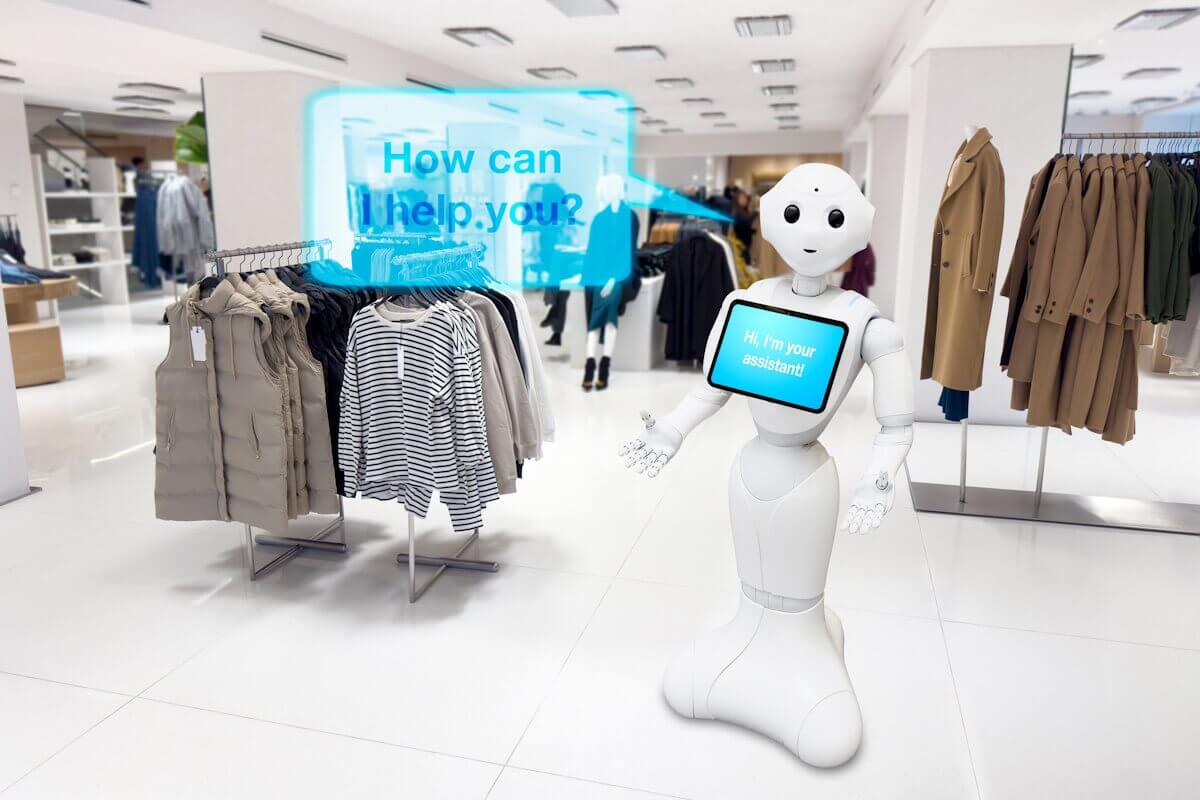AI in Retail: Stay Ahead, Stay Agile, Stay Customer Centric!
By 2028, the AI in retail market is set to hit $29.45 billion, with adoption rates skyrocketing from 40% to over 80% in the next three years. AI-powered conversational interfaces drive revenue increases of $0.50 to $1.30 per visitor, revolutionizing retail with personalized experiences and efficient operations. AI optimizes supply chains, boosts customer engagement, and streamlines processes, reshaping the industry for unprecedented growth and innovation. It stands at the forefront of retail’s future, poised to redefine the shopping experience.

Stuck in the Past
The High Cost of Retailers Resisting AI and Future Tech Advancements
Legacy systems, which were previously the foundation of numerous retail enterprises, are currently in decline as a result of the swift progressions in Artificial Intelligence (AI) and forthcoming technologies. These antiquated systems frequently lack the flexibility and agility needed to meet the constantly changing needs of customers and market trends. Retailers who choose not to adopt AI or other cutting-edge technology will consequently have formidable obstacles to their competitiveness, efficiency, and consumer satisfaction.
Failure to implement cutting-edge ideas could hinder an organization’s progress and prosperity. For instance, challenges in delivering personalized recommendations, optimizing supply chain management, and providing seamless omnichannel experiences are critical in today’s retail landscape. Inefficient operations and missed opportunities may result from a lack of data-driven insights and automation.
In the current dynamic global landscape, adopting artificial intelligence (AI) and forthcoming technologies is not a luxury but an imperative for maintaining relevance and growth in the fiercely competitive retail sector.
Ignoring this reality will only lead to negative impacts on the business, making it imperative for retailers to adapt and evolve with the times.
Incompatibility and Rigidity
Legacy systems made with outdated tech are often incompatible with modern software development solutions and hardware, limiting their ability to adapt to new tech. This lack of flexibility can be a problem for businesses, like retail stores using old Point-of-Sale (POS) systems struggling to add new payment methods.
In June 2019, Target experienced a nationwide POS system outage due to a malfunction in their technology infrastructure. The outage affected checkout processes, leaving customers unable to complete purchases. Target faced financial losses, negative publicity, and frustrated customers who abandoned their shopping carts. The incident highlighted the importance of maintaining reliable and up-to-date POS systems.
Outdated POS systems can lead to lost sales, frustrated customers, and reputational damage for retailers. As a result, retail businesses need future-proof POS systems for a smooth customer experience.
Lack of Regular Updates and Support
Insufficient support and regular updates are commonplace for legacy systems as a result of the absence of their original developers or vendors. This problem causes operational inefficiencies, non-compliance with regulations, and security risks. For instance, a retailer using an outdated inventory management system may struggle to manage stock levels, resulting in stockouts or overstocking, which can lead to lost sales and increased expenditures.
One of the main reasons Toys “R” Us filed for bankruptcy in 2017 was their out-of-date IT infrastructure, which included their inventory management system.
Toys “R” Us used an outdated inventory system with manual processes and old technologies. They faced issues with inventory accuracy, leading to stock shortages and excess products. This affected their ability to meet consumer demand, resulting in lower sales and profitability.
Popular products out of stock during holidays due to ineffective inventory management, causing lost items. The system also didn’t locate slow-selling items, leading to overstocking and cash waste. Resulting in higher storage costs, frequent discounts, and poor financial performance.
This is an example of how an old inventory management system can hurt a store’s business. To remain competitive in the fast-paced retail environment, businesses must invest in high-tech infrastructure.
Data Silos and Inefficiencies
Data silos manifest when distinct systems are utilized to store information, impeding the smooth exchange and analysis of data throughout the organization. Missed chances and slowed decision-making are possible results of this inefficiency. Retail businesses that have data silos may find it difficult to identify trends in consumer behavior, which could result in poor marketing tactics and lower customer satisfaction.
According to a NewVantage Partners survey, just 28% of businesses claimed success in their attempts to become data-driven in 2020, despite 91% admitting the value of data and analytics. This suggests that data silos are a problem for many businesses, including retailers, which can make it more difficult for them to identify trends in customer behavior.
AI Revolution
Transforming Retail Through Data-Driven Insights and Personalized Experiences
In the dynamic retail industry, businesses must prioritize the adoption of cutting-edge technologies in order to maintain competitiveness and ensure the sustainability of their operations in the long run. Conventional legacy systems frequently succumb to the challenges posed by evolving market dynamics and the need to manage intricate customer requirements and scalability.
Retail organizations can strategically utilize AI-powered technological infrastructure to harness the potential of data-driven insights, individualized consumer experiences, and streamlined supply chain operations. This transition not only amplifies competitiveness but also empowers enterprises to maintain a competitive edge, thereby guaranteeing long-term growth and progress.
The retail sector will be radically altered by the adoption of AI technology, paving the way for a future characterized by enhanced intelligence, adaptability, and customer-centricity.
Phygital Commerce
The integration of physical and digital shopping experiences, dubbed “phygital,” is gaining traction. Retailers are merging online and offline platforms to offer more seamless shopping experiences. Customers can, for example, browse merchandise online before picking it up in-store, or the other way around. By utilizing technology, this trend seeks to improve consumer engagement and convenience.
For instance, Tesco successfully merged its online and offline channels in order to offer a unified shopping experience. The company grew from a collection of booths in a marketplace into a retail behemoth. Tesco has put a lot of effort into customer service both in-store and online. In South Korea, they even opened the first virtual food store in the world. Their creative approach to digital retailing and emphasis on customer-centric initiatives have helped them succeed.
Mobile and Social Shopping
Mobile devices play a central role in the shopping experience. Retailers are optimizing their mobile apps and websites for easy navigation, personalized recommendations, and secure transactions. Additionally, social media platforms are becoming powerful channels for product discovery and direct purchasing.
Thomas Husson, Vice President at Forrester Research, aptly puts it:
“Mobile is becoming not only the new digital hub but also the bridge to the physical world. That’s why mobile will affect more than just your digital operations – it will transform your entire business.”
AI and Machine Learning
AI is everywhere in retail. Machine learning algorithms power recommendation engines, fraud detection, inventory optimization, and demand forecasting.
Amazon’s “Amazon Recommender System.” drives tailored content suggestions. By leveraging a blend of collaborative filtering, item-based filtering, and demographic data, this system proposes films, television programs, and products to users in accordance with their purchase and browsing histories.
More than fifty percent of all products sold on Amazon’s platform were reportedly influenced by the company’s recommendation system. This shows how customization boosts user engagement and satisfaction.
Embrace the Future, Transform with Ease
Your Bridge to AI-Driven Success in Retail Tech
It is a complex and expensive endeavor to bridge the technology infrastructure divide during the migration from legacy systems to AI-driven, future-proof infrastructure. However, it is important for retailers to stay ahead of the competition and use AI to its full potential. This is a multi-step process that calls for knowledge of AI technology as well as legacy systems.
There are multiple stages to the process:
a) Assessment: Evaluate the current setup carefully to find out what needs fixing and what kind of AI capabilities are necessary.
b) Planning: Formulate an all-encompassing strategy that delineates the transition procedure, encompassing resources, budgets, and schedules.
c) Migration: Gradually move data and apps from old systems to AI-based infrastructure to minimize business interruption.
d) Integration: Connect AI solutions to current systems and methods to make sure that data and interactions flow smoothly.
e) Testing and Optimization: Conduct exhaustive performance optimization and testing on the new infrastructure to maximize its efficiency and effectiveness.
f) Maintenance and Upgrades: Maintain the infrastructure in a future-proof state by implementing necessary updates and enhancements while conducting ongoing monitoring and maintenance.
Given the complexities and costs involved, it is critical to seek the assistance of Artificial Intelligence development specialists. Weblineindia AI software development experts can provide affordable offshore outsource AI solutions that meet your unique requirements and financial constraints. Weblineindia can help you manage the transition process more smoothly, allowing you to maximize your investment in AI technology.
By capitalizing on the expertise and understanding of AI in retail development specialists, organizations can establish a technological infrastructure that is resilient to future developments and fosters growth and innovation. This collaboration enables firms to remain competitive in an ever-changing technological context, while simultaneously encouraging a constructive and equitable approach to digital change.
Retailers must embrace AI-based technology infrastructure to thrive in today’s competitive market. The transition from legacy systems to future-proof technology is vital for growth. Weblineindia specialists, known for their expertise in AI, data migration, and end-to-end digital transformation, can assist retailers in this process to maintain agility and drive innovation. In the words of the well-known quote, “Innovate or die,” embracing AI can help retailers not only survive but also thrive.
WeblineIndia provides bespoke mobile and web development services and software solutions to small, medium-sized, and large enterprises in USA, UK, Canada, Australia, and New Zealand.

As a Digital Marketing Specialist, I have over 10 years of experience helping businesses improve their online visibility and reach. I have a proven track record of success in developing and executing SEO & content marketing strategies that deliver results. I am also an experienced content writer and marketer, and I am passionate about creating content that is both informative and engaging.










